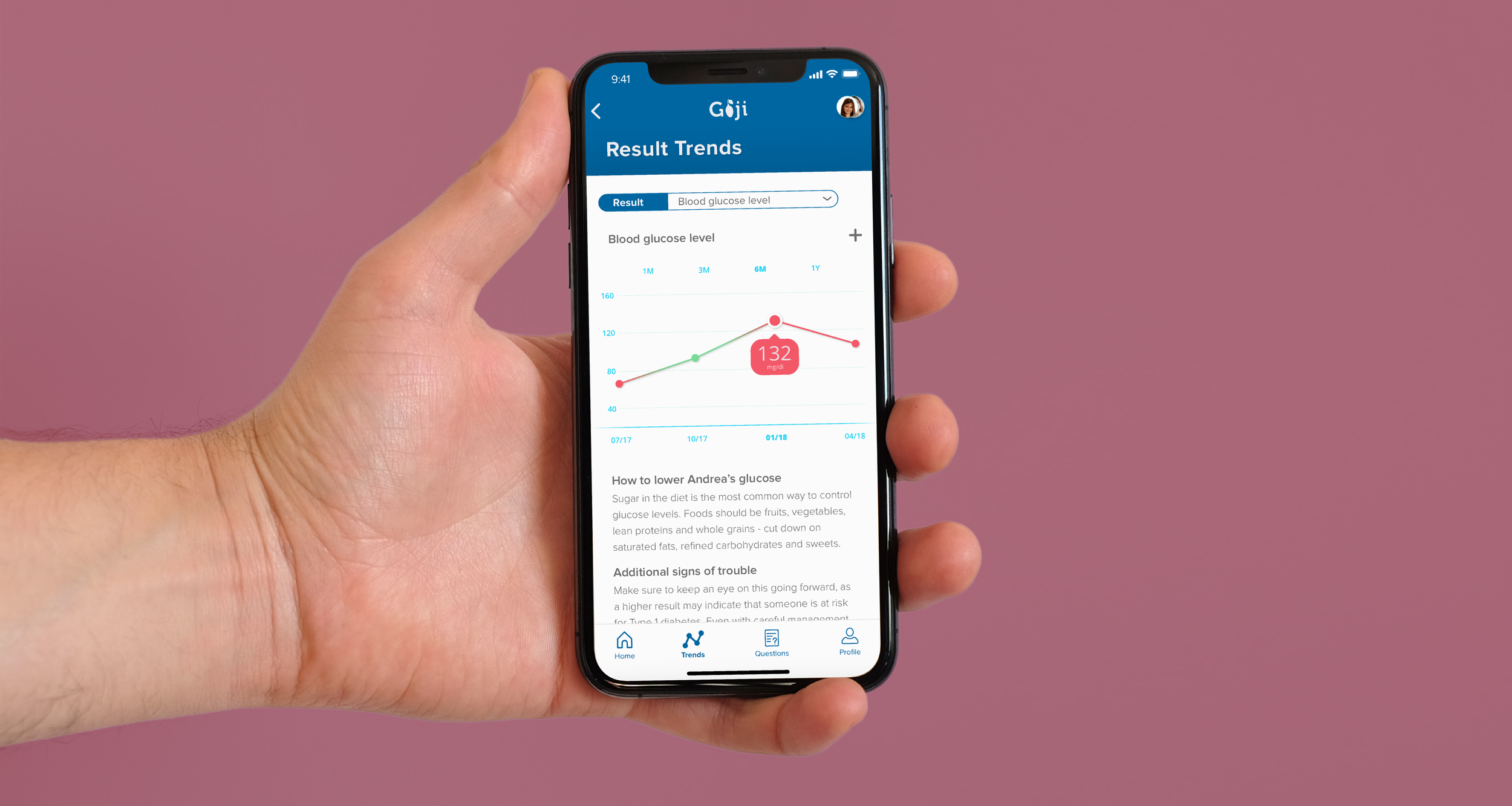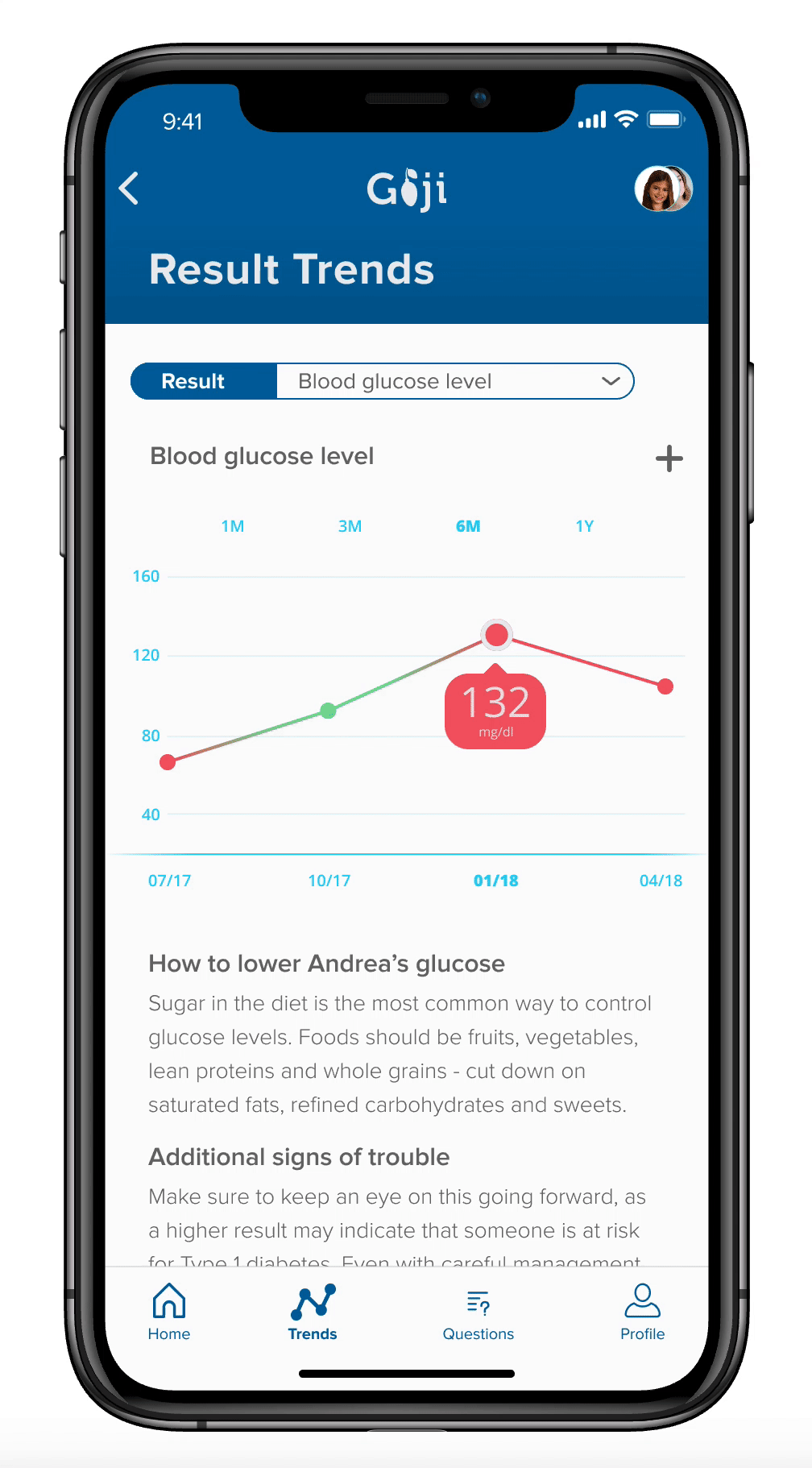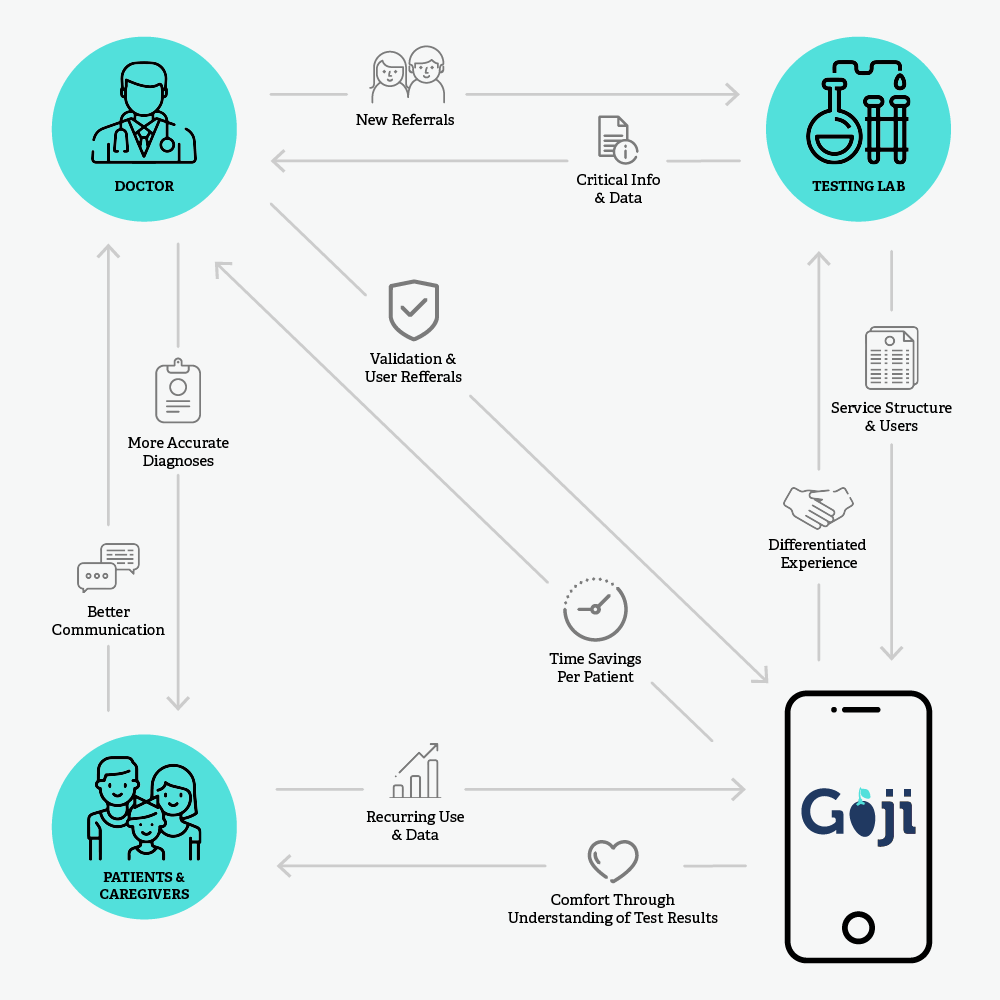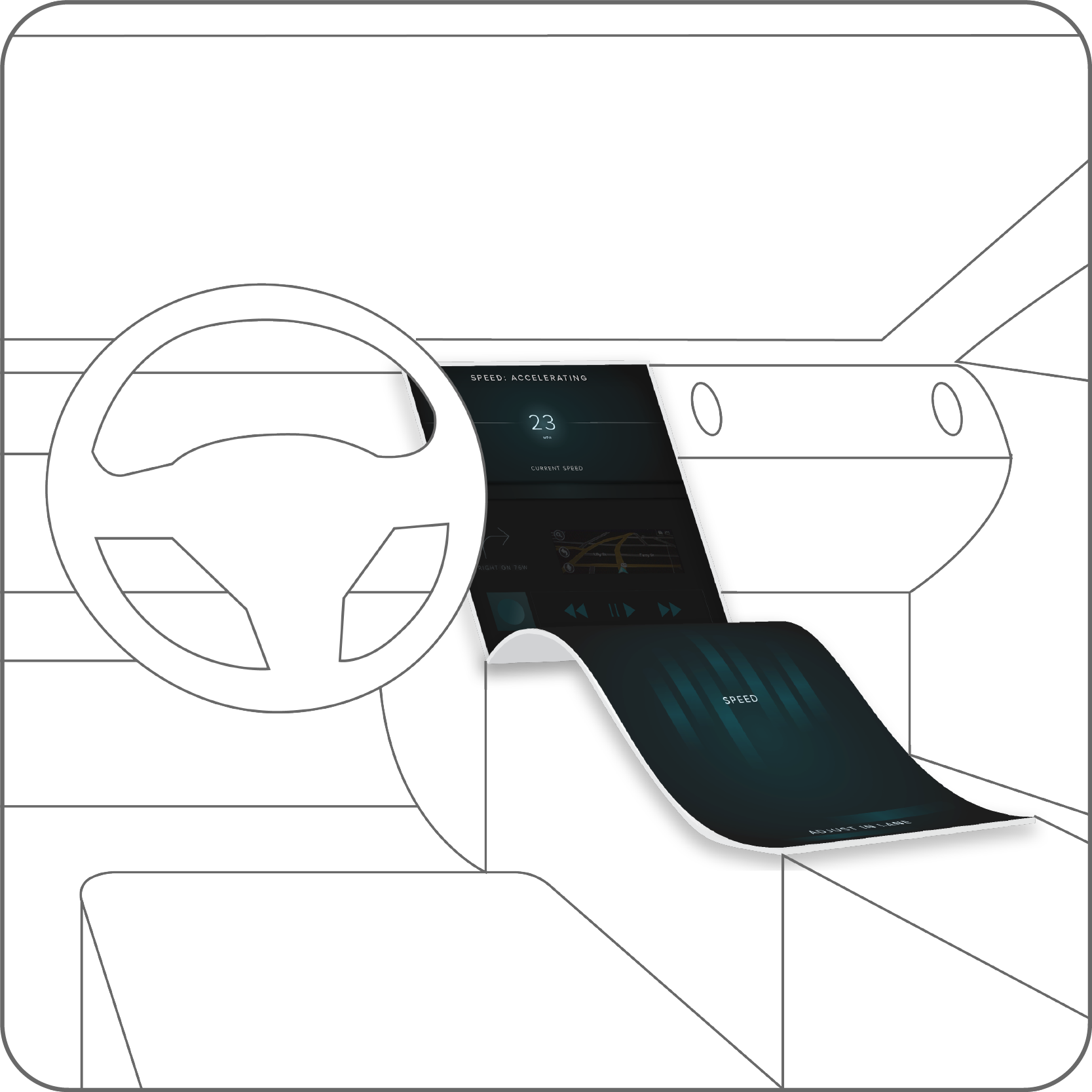Goji
Mobile app helping parents understand their children’s medical lab test results
Carnegie Mellon Project
ROLE
Lead Product Designer & Product Manager
[ 5 person team ]
TIMELINE
March - May 2018
METHODS
Information architecture, UX wireframing, UI visual design, continuous discovery through qualitative & stakeholder interviews, journey map, persona building, user survey, value flow, product roadmap
PROBLEM
Medical lab test results are difficult to read and interpret, especially when there is a red flag. Parents of young children feel particularly vulnerable and anxious when they are searching for answers. They want the results shown to them in a simple way in order to evaluate the urgency and have a purposeful conversation with their doctor.
SOLUTION
A mobile app that alleviates anxiety in parents of young children by visualizing and explaining their lab results in a language they can understand, showing trends, and creating a question list for their doctor. Creating meaningful parent-doctor interactions by preparing parents to ask the right questions during a doctor visit.
PROCESS
With EHRs becoming more open to patients, we focused on creating a personalized healthcare experience. Through qualitative user and stakeholder research we scoped in on an initial target user, and created an MVP. User testing made sure features aligned with user’s needs and goals.
FINDINGS
Users see lab results as a pathway to determining the urgency of treatment, but the most accessible resources for result explanation are not the most helpful. Without having information on hand, they miss important questions when visiting the doctor’s office.
Final Design: Turning Complexity Into Actionable Information
reducing parents’ anxiety with explanations
Progressive disclosure of data
Medical lab test results are presented in bite-sized pieces to promote comprehension from the user. If users need more information, they can dive into the details, but without overwhelming themselves up front. Explanations are available when necessary.
Discoverability of features
Simple navigation allows for key views and features allow useful information to be readily available when users need. Depending on their situation, users can quickly refer to results, trends, and questions with ease.
Simple Visualizations
GLANCEABLE DASHBOARD
Tracked results are displayed alongside the latest tests in chronological order, showing a snapshot of the child’s condition.
CLEAR RESULTS
Results are presented in as individual tiles with clearly marked ranges, making it easy to assess the severity of the abnormal finding. A short explanation and options are available to view inside of the card’s accordion.
Personalized Explanations
DETAILED EXPLANATION
When a parent has a deeper question about the meaning of a result, a simple and detailed explanation is at the ready.
VISUAL COMPARATIVE RESULTS
To understand what a specific result actually means, we visualize the data point where it falls within the spectrum of similar patients.
Deeper Insights
TRENDS FROM PAST RESULTS
Users can see visual historical data for every result, and evaluate trends. The trendline combines historical values with out-of-bound numbers, highlighted by signal colors, on the same graph.
JUST ENOUGH INFORMATION
We don’t want to prevent seeking a medical opinion on the subject matter, just enough to empower the user to ask the right questions and know the next steps.
Improved Doctor-Patient Interactions
ASK THE DOCTOR A QUESTION
At any point, users can trigger a context-sensitive Question Form to build a list of questions for the doctor’s visit. Questions can be assigned to multiple doctors, and ranked by urgency.
STAY ON TRACK
The most recent questions can be sorted by the type of doctor and specific test. Once answered, they are archived but not removed for easier recall at home.
Co-creation of Value for All Stakeholders
Patients & Caregivers
Through understanding and tracking their test results, users will gain insight into results quicker, have meaningful interactions with doctors and healthcare staff, and ultimately have less anxiety.
Doctors
With a more educated patient base, doctors can have more purposeful conversations with patients. Better questions lead to more insight, which creates more accurate diagnoses.
Testing Labs
Labs can use Goji as a platform for delivering test results to their patients - creating a stronger and more personalized experience, differentiating their services in a commoditized market.
Continuous Discovery: Journey to an MVP
Diving into the healthcare opportunity
Our goal was to gain empathy for patients through qualitative interviews, surveying, storyboarding, and journey mapping, we developed a design persona that perfectly encapsulated our MVP user. We begun with a mission to identify gaps in the healthcare experience, where a service solution could help the patient experience, with the process resulting in a narrowly scoped set of MVP features.
Product Opportunity Analysis
Exploring the healthcare sphere using PESTLE/SET methodologies
Stakeholder Interviews
Discovery interviews with doctors and lab company employees to identify how they interact with patients.
Patient Interviews
Qualitative interviews diving into their process for receiving lab tests and patient journey
Survey of Parents
Once we narrowed down to a specific user group, we needed to understand their specific needs & goals
Insight 1
Patients want a personalized experience
The largest gap sits within the commoditized experience that healthcare providers are offering. Healthcare providers are looking to bring more value into the patient experience to offset rising patient costs.
TIME AT THE DOCTOR IS DECREASING
Millennials & Gen Y/Z don’t think they can afford healthcare, but are still very health conscious. They seek other sources of info, anywhere.
LESS DIFFERENTIATION BETWEEN PROVIDERS
Patient choice behavior is starting to resemble the retail model due to open markets, services are becoming more commoditized.
EHRs ARE BECOMING MORE OPEN TO PATIENTS
Thanks to new systems development and legislation patients have access to their data, doctors are seeing a higher demand for results.
Insight 2
Users turn to unreliable sources, get more confused
When users see an out-of-range result, they begin to search around on the internet (with no consistent source), or call friends and family who may have had experience with this in the past. There is no guarantee of accurate information, and if there are specifics, they are usually tailored to another person’s experience.
Insight 3
Doctors only reveal information that a patient is ready to hear
Doctor visits are inherently time blocked with both sides wanting to make the most of them. A doctor’s goal is to inform the patient but not overwhelm them, so if a patient is not well researched or is not ready with engaging questions, key information may not be exchanged.
Insight 4
Caregivers, especially parents of young children, feel the ‘need to understand’ most acutely
Testing our assumptions with a survey, we identified that caregivers, especially parents of young children, are the most emotionally compromised when receiving confusing lab test results for their kids. This opened up an opportunity for niche targeting on a population that will need this service the most.
Focusing on an initial target user
Parents seek reliable information, in order to have a more meaningful conversation with their doctor, about their kids
Click to see full pesona
Cory & Alex (MVP Persona)
New to parenting, they take their daughter Andrea in for routine blood tests and analyses frequently.
Knowledge of possible symptom severity (catching issues early)
Finding credible source of medical information
Make the most out of the time they spend with the doctor
“We need to understand what my kid’s abnormal lab test results actually mean, and read about them in a plain language, so we know what to ask our doctor.”
Prototyping The Experience
aligning User Needs with Features
Identifying user flow with lo-fi wireframes
We started by mapping our target user persona to a set of discrete features, resulting in a screen flow. Testing our assumptions about components with users revealed unnecessary features like appointment scheduling and being able to take a photo of a paper test result.
Matching Explanations to User’s Mental Models
Detailed wireframes
User testing revealed that in addition to detailed explanation of a result, users expect to see how their child’s result compared with others. This is a common way for a doctor to explain other medical issues, and it helps them evaluate just how urgent an out-of-range result actually is. Information architecture, visualizations, and layouts were refined to match how users thought about their child’s results.
Increasing discoverability and saliency
Final visual design
Breaking down information presentation into smaller pieces created easily digestible explanations and visualizations. Navigation structure and annotation was simplified for easier discoverability and information comprehension. Visual design and signal colors for out-of-range scores were designed to be as salient as possible while maintaining a high degree of contrast for maximum legibility.
Next Steps
Our database grows as we expand our market
The MVP focuses on translating blood test results for parents of young children, because they are the most likely to become first adopters and frequent users. However this service is extremely useful for many other populations, but that requires additional updates and development.
Additional phases will expand with user base by providing more translatable lab tests as well as offering new features for new types of users.
Other Projects















